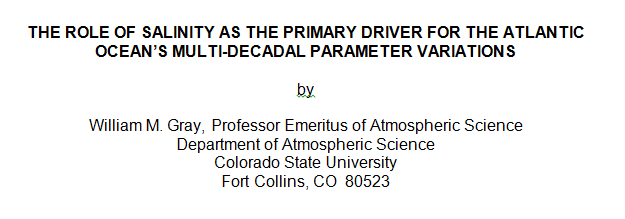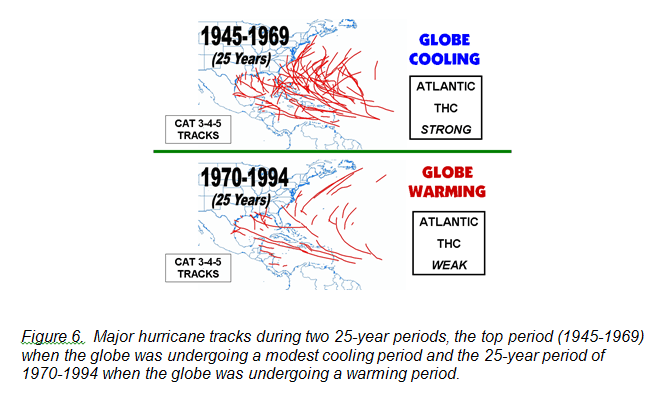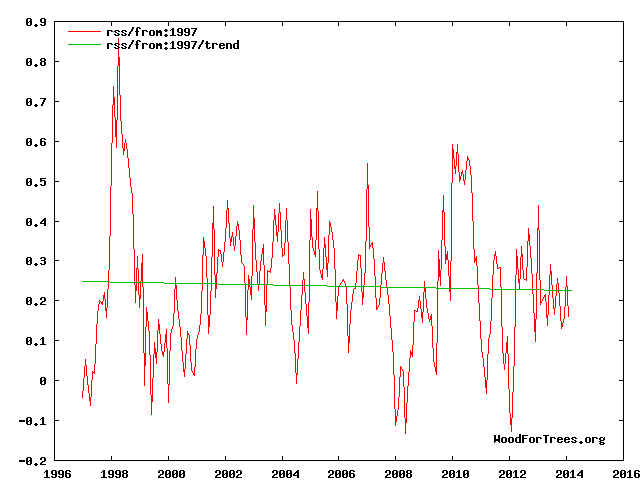One of the things I have learned from Bill Gray, is that major hurricane activity increases during cooling periods, and decreases during warming periods.
During the strong cooling from 1945-1969, there were a lot of major hurricanes. In the 1970’s, temperature trends reversed – and major hurricane activity dropped off dramatically.
Before NASA/NOAA erased the post-1940 cooling, the National Academy of Sciences showed that it was as large as the 1900-1940 warming

In the late 1990’s, temperatures began to decline and major hurricane activity picked up sharply again.

Next topic will be what is causing the warming and cooling periods, but the key point for now is that alarmists have the relationship between major hurricanes and global warming exactly backwards.





From what I have read you have several factors, one of which is the Delta T between the equator and the poles.
The salinity factor is interesting since that ties back into the West Wind Drift aka Antarctic Circumpolar Current and the ice in the antarctic.
Decadal Changes of Wind Stress over the Southern Ocean Associated with Antarctic Ozone Depletion.
So there has been a change in the winds driving the current.
More on the Antarctic Circumpolar Current
A decent map and discription of the currents can be found here: CHAPTER 31 OCEAN CURRENTS: TYPES AND CAUSES OF CURRENTS (Maritime Safety Information)
Slightly off topic:”Australia’s record hot year much more likely because of global warming: report
http://www.smh.com.au/environment/climate-change/australias-record-hot-year-much-more-likely-because-of-global-warming-report-20140325-35f9q.html
Substitute “USA” for “Australia” and “global cooling” for “global warming”. We all know how that would go over with the warmists.
http://www.abc.net.au/news/2014-03-25/nrn-grain-rain/5343736
And yet there are widespread autumn rains across the eastern wheatbelt.
Alarmists say this rain is caused by the carbon tax, and there will be no rain if it is repealed.
Paper By Don J Easterbrook – Geologic Evidence of Recurring
Climate Cycles and Their
Implications for the Cause of
Global Climate Changes – The
Past is the Key to the Future
http://myweb.wwu.edu/dbunny/pdfs/easterbrook_geologic-evidence-of-recurring-climatic-cycles.pdf
See Page 47 for Easterbrooks short term forecast.
Alarmists worldwide will be burning effigy’s of him provided they are made from hydrogen and not carbon.
Confirmed by BOM:
Australian cyclones were more prevalent in low CO2 environment than in “high” CO2 environment. Cool climate means more cyclones, warm climate means less cyclones.
“Trends in tropical cyclone activity in the Australian region (south of the equator; 90–160°E) show that the total number of cyclones appears to have decreased to the mid 1980s, and remained nearly stable since. ”
http://www.bom.gov.au/cyclone/climatology/trends.shtml
History of severe Queensland Cyclones from 1867 to 1927
http://trove.nla.gov.au/ndp/del/article/40562844
List of severe American Hurricanes 1872 – 1897
23 January 1897
http://trove.nla.gov.au/ndp/del/article/71288949
If this were the case, wouldn’t there have been a noticeable increase during the early to mid 90’s when the PDO went slightly negative and we had Pinatubo cooling the globe?
Hurricanes aren’t the only thing they have backwards.
Actually, hurricane activity is based on sunspot activity. The periods mentioned,1945 to 69 had higher sunspot activity. The 70s Had a flat cycle with same amount of numbers as the last cycle of this past century, but it had a peak. The last two cycles not the decline and pulse in global temperatures. It was noted at a hurricane conference I attended in Greece that hurricanes are in decline. I add, so are temperatures.
Paul Pierett